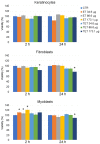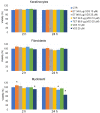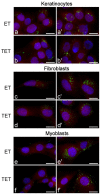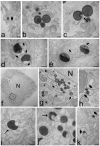Formulative Study and Intracellular Fate Evaluation of Ethosomes and Transethosomes for Vitamin D3 Delivery
- PMID: 34069489
- PMCID: PMC8161393
- DOI: 10.3390/ijms22105341
Formulative Study and Intracellular Fate Evaluation of Ethosomes and Transethosomes for Vitamin D3 Delivery
Abstract
In this pilot study, ethosomes and transethosomes were investigated as potential delivery systems for cholecalciferol (vitamin D3), whose deficiency has been correlated to many disorders such as dermatological diseases, systemic infections, cancer and sarcopenia. A formulative study on the influence of pharmaceutically acceptable ionic and non-ionic surfactants allowed the preparation of different transethosomes. In vitro cytotoxicity was evaluated in different cell types representative of epithelial, connective and muscle tissue. Then, the selected nanocarriers were further investigated at light and transmission electron microscopy to evaluate their uptake and intracellular fate. Both ethosomes and transethosomes proven to have physicochemical properties optimal for transdermal penetration and efficient vitamin D3 loading; moreover, nanocarriers were easily internalized by all cell types, although they followed distinct intracellular fates: ethosomes persisted for long times inside the cytoplasm, without inducing subcellular alteration, while transethosomes underwent rapid degradation giving rise to an intracellular accumulation of lipids. These basic results provide a solid scientific background to in vivo investigations aimed at exploring the efficacy of vitamin D3 transdermal administration in different experimental and pathological conditions.
Keywords: cell culture; cholecalciferol; cryogenic transmission electron microscopy; in vitro test; light microscopy; lipid nanocarriers; transmission electron microscopy.
Conflict of interest statement
The authors declare no conflict of interest.
Figures








Similar articles
-
Development, characterization, and skin delivery studies of related ultradeformable vesicles: transfersomes, ethosomes, and transethosomes.Int J Nanomedicine. 2015 Sep 18;10:5837-51. doi: 10.2147/IJN.S86186. eCollection 2015. Int J Nanomedicine. 2015. PMID: 26425085 Free PMC article.
-
Ex Vivo Evaluation of Ethosomes and Transethosomes Applied on Human Skin: A Comparative Study.Int J Mol Sci. 2022 Dec 1;23(23):15112. doi: 10.3390/ijms232315112. Int J Mol Sci. 2022. PMID: 36499432 Free PMC article.
-
Dimethyl Fumarate-Loaded Transethosomes: A Formulative Study and Preliminary Ex Vivo and In Vivo Evaluation.Int J Mol Sci. 2022 Aug 6;23(15):8756. doi: 10.3390/ijms23158756. Int J Mol Sci. 2022. PMID: 35955900 Free PMC article.
-
Transethosomes: A Comprehensive Review of Ultra-Deformable Vesicular Systems for Enhanced Transdermal Drug Delivery.AAPS PharmSciTech. 2025 Jan 17;26(1):41. doi: 10.1208/s12249-024-03035-x. AAPS PharmSciTech. 2025. PMID: 39825015 Review.
-
Ethosomal nanocarriers: the impact of constituents and formulation techniques on ethosomal properties, in vivo studies, and clinical trials.Int J Nanomedicine. 2016 May 25;11:2279-304. doi: 10.2147/IJN.S105016. eCollection 2016. Int J Nanomedicine. 2016. PMID: 27307730 Free PMC article. Review.
Cited by
-
Ethosomes and Transethosomes as Cutaneous Delivery Systems for Quercetin: A Preliminary Study on Melanoma Cells.Pharmaceutics. 2022 May 11;14(5):1038. doi: 10.3390/pharmaceutics14051038. Pharmaceutics. 2022. PMID: 35631628 Free PMC article.
-
"Plurethosome" as Vesicular System for Cutaneous Administration of Mangiferin: Formulative Study and 3D Skin Tissue Evaluation.Pharmaceutics. 2021 Jul 23;13(8):1124. doi: 10.3390/pharmaceutics13081124. Pharmaceutics. 2021. PMID: 34452085 Free PMC article.
-
Ginger Extract-Loaded Transethosomes for Effective Transdermal Permeation and Anti-Inflammation in Rat Model.Int J Nanomedicine. 2023 Mar 15;18:1259-1280. doi: 10.2147/IJN.S400604. eCollection 2023. Int J Nanomedicine. 2023. PMID: 36945254 Free PMC article.
-
Rutin-Loaded Nanovesicles for Improved Stability and Enhanced Topical Efficacy of Natural Compound.J Funct Biomater. 2021 Dec 13;12(4):74. doi: 10.3390/jfb12040074. J Funct Biomater. 2021. PMID: 34940553 Free PMC article.
-
In Vitro Models of Biological Barriers for Nanomedical Research.Int J Mol Sci. 2022 Aug 10;23(16):8910. doi: 10.3390/ijms23168910. Int J Mol Sci. 2022. PMID: 36012181 Free PMC article. Review.
References
MeSH terms
Substances
Grants and funding
LinkOut - more resources
Full Text Sources

